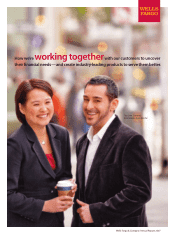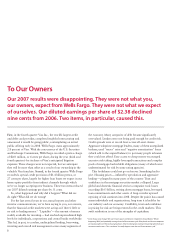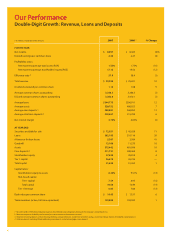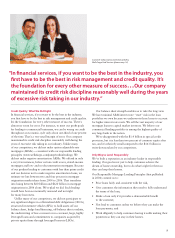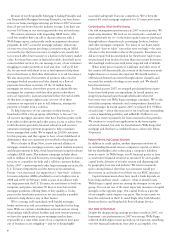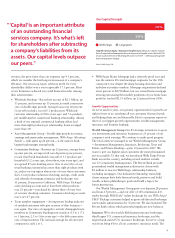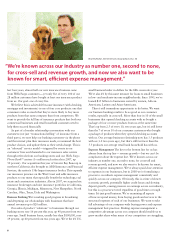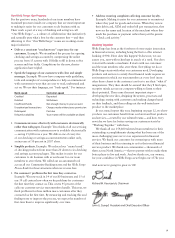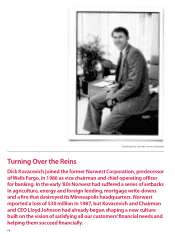Wells Fargo 2007 Annual Report Download - page 8
Download and view the complete annual report
Please find page 8 of the 2007 Wells Fargo annual report below. You can navigate through the pages in the report by either clicking on the pages listed below, or by using the keyword search tool below to find specific information within the annual report.6
Because of our Responsible Mortgage Lending Principles and
our Responsible Mortgage Servicing Principles, our foreclosure
rate in our home mortgage servicing portfolio in 2007 was more
than 20 percent better than the industry average. Less than one
in every 100 loans in our servicing portfolio was in foreclosure.
We contact customers with impending ARM resets, offer
a toll-free number they can call to discuss solutions with a
Wells Fargo expert, and provide credit management education
programs. In 2007 across the mortgage industry, almost one
of every two foreclosures involving a customer with an ARM
occurred before the loan was reset at a higher rate, mostly due
to too much debt, lower income or a decline in the home’s market
value. For those borrowers in financial trouble, about half never
contacted their servicer. So, our message to any of our customers
struggling to make payments is loud and clear: Call us! If they
do, we can work with them to try to find options to help them
stay in their home or find other alternatives to avoid foreclosure.
We also must protect the interests of investors who own the
mortgage-backed securities and who depend on a flow of
payments from those securities. Of the 10 million home
mortgages we service, about three percent are adjustable-rate
mortgages for customers with less than prime credit whose
rates are expected to increase sometime before the end of 2008.
At this time, it appears eight to nine of every 10 of these
customers are expected to pay in full, refinance, manage the
payment or benefit from a solution.
To help keep more of our customers in their homes, we
launched in 2006 a free program called Steps to SuccessSM for
all our new mortgage customers who have less than prime credit.
It provides credit reports and credit scores, access to advice from
credit education specialists, financial education and access to
automatic mortgage payment programs to help consumers
better manage their credit. We’ve signed up 20,000 customers
for this program, and they appear to have a lower likelihood of
delinquency than our customers not enrolled in this program.
We’re a leader in Hope Now, a new national alliance of
mortgage counselors, mortgage servicers, capital markets investors
and the government to help at-risk homeowners facing foreclosure
or higher ARM resets. The industry campaign includes direct
mail to millions of at-risk borrowers, encouraging them to contact
servicers or counselors for help and a toll-free customer hotline.
In late 2007 — partnering with other large mortgage servicers, the
U.S. Treasury Department and the American Securitization
Forum — we announced our support for a “fast-track” solution
for many subprime ARMs scheduled to reset to higher rates in
2008 and 2009. In February 2008, as part of an alliance with
our large peers and the U.S. Treasury, we sent letters to both our
nonprime and prime customers 90 days or more late in their
mortgage payments, offering them, if they qualify, a 30-day
pause in the foreclosure process so we can consider a possible
solution to help them to stay in their homes.
We’re a strong, well-capitalized, well-funded mortgage
lender and servicer and can maintain our liquidity for the long
term. With our extensive distribution network and our strong
relationships with Realtors®
, builders and joint venture partners,
we have the opportunity to grow mortgage market share
responsibly at a time when some of our competitors have gone
out of business or are struggling — and we’re hiring highly
successful salespeople from our competitors. We’ve been the
nation’s #1 retail mortgage originator for 15 consecutive years.
Credit Quality: What We Did Wrong
Our risk management performance in 2007 was not perfect. We
made some mistakes. We took on too much risk — and did not
price sufficiently for it — in the home equity loans we purchased
through indirect channels such as mortgage brokers, bankers
and other mortgage companies. Too many of our home equity
loans had “loan-to-value” ratios that were too high — the ratio
of loans to the fair market value of the property. Sometimes we
did not require full documentation for these home equity loans
we purchased from brokers because these were prime borrowers
who had high credit scores with lower expected risk of default.
When home prices in parts of California and other areas of
the country fell dramatically, the severity of the losses was much
higher than we or anyone else expected. We should not have
offered such lenient loan terms through indirect channels, and
we made the mistake of taking on too much risk. We should
have known better.
In third quarter 2007, we stopped purchasing home equity
loans from third-party correspondents. In fourth quarter, we
stopped purchasing loans through wholesalers when the
borrowers were not Wells Fargo mortgage customers. We’ve also
exited the nonprime wholesale and correspondent channels for
first mortgages. In fourth quarter 2007, we placed $11.9 billion
of such loans — about three percent of our total loans outstanding
— into a liquidating portfolio, and added $1.4 billion to our
credit loss reserves primarily for losses incurred in this portfolio.
We continue to accept loan applications in the home equity
wholesale channel, but only for loans behind a Wells Fargo first
mortgage and that have a combined loan-to-value ratio below
90 percent.
Balance Sheet and Capital Strength
In addition to credit quality, another important attribute of
an outstanding financial services company is capital, or what’s
left for shareholders after subtracting a company’s liabilities
from its assets. At Wells Fargo, our #1 financial goal is to have
a conservative financial structure as measured by asset quality,
capital levels, diversity of revenue sources and dispersing risk
by geography, loan size and industry. We want to maintain
such a strong balance sheet that our customers would put
their money in our banks even if there was no FDIC insurance.
Capital measurements show how much a bank depends on
borrowing and how much “cushion” it has to absorb losses.
Wells Fargo’s capital ratios are among the strongest in our peer
group. You can see one of the most important measures of capital
strength on the opposite page. Our capital levels as a percent
of our tangible assets outpace our peers. This is one reason we
have the only bank in the U.S. rated Triple A by both Moody’s
Investors Service and Standard & Poor’s Ratings Service.
Our 2007 Performance
Despite the disappointing earnings-per-share results in 2007, our
businesses’ core performance in 2007 was strong. Wells Fargo
achieved double-digit revenue growth, up 10.4 percent, something
very few financial institutions were able to accomplish. Our

